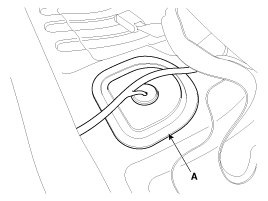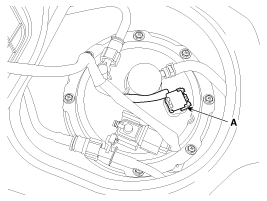 Hyundai Accent: Release Residual Pressure in Fuel Line
Hyundai Accent: Release Residual Pressure in Fuel Line
Hyundai Accent RB (2010-2018) Service Manual / Engine Control/Fuel System / Fuel Delivery System / Release Residual Pressure in Fuel Line
Whenever the high pressure fuel pump, fuel pipe,
delivery pipe, or injector is removed immediately after shutting off
the engine, an injury may be caused by the release of highly pressurized
fuel. Release the residual pressure in the high pressure fuel line by
referring to the "Residual fuel pressure release procedure" below before
removing any high pressure fuel system components.
|
Wear safety glasses and fuel resistant gloves.
|
| 1. |
Turn the ignition off and disconnect the battery
negative cable.
|
| 2. |
Remove the rear seat cushion. (Refer to Bady - "Seat")
|
| 3. |
Remove the service cover (A).
|
| 4. |
Disconnect the fuel pump connector (A).
|
| 5. |
Disconnect the electrical connector from the high
pressure fuel pump.
|
| 6. |
Reconnect the battery negative cable.
|
| 7. |
Run the engine for about 20 seconds to lower the
pressure in both the high or low pressurelines. The engine may shut
off within the 20 second period. If not, turn the engine off.
|
| 8. |
Proceed with the service or repair. Use rags to cover
opening and catch spills when opening up the high pressure system.
|
| 9. |
Reinstall / re-connect all components in reverse
order of removal. Start engine and confirm proper operation, and make
sure there are no fuel leaks.
|
| 10. |
After completing, clear DTC(s) using GDS scan tool
(the procedure described above will cause DTC to set).
|
 Repair procedures
Repair procedures
Fuel Pressure Test
1.
Release the residual pressure in fuel line (Refer
to “Release Residual Pressure in Fuel Line” in this group).
...
See also:
Installation
1.
Install the hazard lamp switch.
2.
Connect the connectors.
3.
Install the center fascia garnish.
...
Circuit Diagram
...
Installation
1.
Install the DRL unit.
2.
Install the glove box.
...
Hyundai Accent Manuals
- Hyundai Accent 2017-2022 Service Manual
- Hyundai Accent 2010-2025 Owners Manual
- Hyundai Accent 2010-2025 Service Manual
© 2011-2025 Copyright www.hamanual.com



